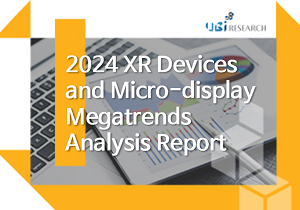Special Report
2022 Micro-display Technology Report
₩5,000,000
March 22, 2022
PDF(116p)Introduction
As the mobile phone of the past had evolved into the smartphone we know today, the smart era that had begun is teeming to evolve once again. This time it is in the form of wearables as in Augmented Reality Glasses otherwise known as, AR Glasses.
A smartphone is classified as a mobile device because it can be carried around and carried in a bag or pocket. However, AR Glasses are classified as wearable devices because it is a device worn on the face.
AR Glasses have transparent glass on the front just like any ordinary glasses and the information to be displayed is also imaged on this glass. This gives the user the advantage to see information immediately while walking. In addition, various information can be displayed on top of visible objects through the transparent glass, making it a new experience different from previous information devices.
As micro-displays, which make up AR Glasses, there are LCoS (liquid crystal on silicon), OLEDoS (OLED on silicon), micro-LED, MEMS, etc., in which liquid crystal or OLED is placed on a silicon substrate.
In addition to AR Glasses, VR devices are establishing themselves as essential devices in the Metaverse Era. VR devices will provide a more immersive experience for games and movies than any other preceding devices. For VR displays, micro-displays are mainly used.
Accordingly, the world’s best IT companies such as Apple, Meta, Google, and Sony are spurring on the development and commercialization of AR Glasses and VR devices.
AR Glasses and micro-displays for VR devices will establish themselves as game-changers. These devices are set to replace smartphones and game consoles, and other information devices within the coming years.
In this micro-display report, the product trends of AR Glasses, VR device developers, and the current development status of micro-display (a key component of AR and VR) were thoroughly investigated to analyze technological progress and problems in detail.
Contents
1.1 Overview
1.2 AR
1.3 VR
1.4 XR
1.5 XR equipment
1.6 Micro display
2. AR Development Trends
2.1 Evolution of Information Devices and Displays
2.2 Near-Eye Display Products
2.3 Optical System of Near-Eye Display
– 2.3.1 Projection Type ( look around )
– 2.3.2 Beam Splitter Type Display
– 2.3.3 Waveguide Type Optical system
– 2.3.4 Micro mirror system
– 2.3.5 Retinal scanning display
2.4 Micro-display used in AR Glass
– 2.4.1 Non-Emissive Micro-Display
– 2.4.2 Emissive Micro-Display
2.5 Combination of Display Device and Optics in AR Devices
3. VR Development Trends
3.1 What is required of VR equipment
– 3.1.1 wide FOV
– 3.1.2 High resolution
– 3.1.3 Fast response
3.2 Commercialized VR equipment
– 3.2.1 PlayStation VR
– 3.2.2 Oculus
– 3.2.3 HTC
– 3.2.4 Other VR products with wide FOV and high resolution
– 3.2.5 Display resolution of VR products
3.3 Newly developed VR equipment
– 3.3.1 Panasonic
– 3.3.2 Sony
– 3.3.3 Resolution of newly developed VR equipment
3.4 Support for 3D display
– 3.4.1 Problems with conventional 3D display methods
– 3.4.2 Light field display
4. Micro-OLED
4.1 Status of Micro-OLED Business
– 4.1.1 Micro OLED Structure and Application Areas
– 4.1.2 eMagin
– 4.1.3 Sony
– 4.1.4 MICROOLED
– 4.1.5 Kopin
– 4.1.6 BOE
– 4.1.7 EPSON
– 4.1.8 Specifications of each company’s product lineup
– 4.1.9 Micro OLED product size and pixel pitch of each company
4.2 White + CF type Micro-OLED with high resolution
– 4.2.1 Color Filter array
– 4.2.2 Meta Surface
4.3 White + CF type Micro-OLED with high brightness
– 4.3.1 RGBW Color Filter
– 4.3.2 Tandem
– 4.3.3 Low voltage Tandem
– 4.3.4 Micro Lens array
– 4.3.5 Light distribution control
4.4 RGB Direct Patterning of Micro-OLED
– 4.4.1 Lithography
– 4.4.2 Flash Mask Transfer Lithography ( FMTL )
– 4.4.3 Ultra High Definition Mask
4.5 AR Glass using Micro-OLED
– 4.5.1 EPSON
– 4.5.2 Nreal
– 4.5.3 ETRI
5. Monolithic Micro LED
5.1 Hybridization of Monolithic Micro LED and Driver chip
– 5.1.1 CEA-LETI
– 5.1.2 Sharp
– 5.1.3 GaN on Si wafer
5.2 Mass Production Improvement of Monolithic Micro LED
– 5.2.1 CEA-LETI
– 5.2.2 Jade Bird Display
5.3 Monolithic TFT on GaN Micro LED
5.4 Relationship between size and luminous efficiency of Micro LED
5.5 Nanowire ( Nanocolumn )
5.6 Complete Monolithic Micro LED
5.7 Full Color of Monolithic Micro LED
– 5.7.1 Color conversion by QD
– 5.7.2 Direct color by nanocolumn
– 5.7.3 Quantum Photonic Imager ( QPI )
– 5.7.4 Full color with Monolithic GaN
5.8 Commercialization of Monolithic Micro LED
– 5.8.1 Plessey Semiconductor
– 5.8.2 Jade Bird Display ( JBD )
5.9 AR Glass with Micro LED
– 5.9.1 VUZIX
– 5.9.2 TCL
– 5.9.3 Oppo
6. Micro OLED or Micro LED ?
6.1 View from the Micro OLED side
6.2 Brightness comparison : Micro LED vs Micro OLED
– 6.2.1 Brightness of Micro-LED
– 6.2.2 Brightness of Micro-OLED
6.3 Full Color : Micro LED vs Micro OLED
6.4 Drive Systems and more : Micro LED vs Micro OLED
Report Sample
Previous Report Status
Related Products
-

2024 XR Devices and Micro-display Megatrends Analysis Report
₩0September 9, 2024
PDF(179P)XR is emerging as a key industry that will drive the next generation of IT, following the innovations brought by smartphones, and holds immense value. In the 21st century, smartphones revolutionized the IT industry by integrating features like cameras, gaming, and digital wallets, becoming the leading IT device that continues to evolve.
-

2024 OLEDoS Industry and Technology Report
₩0October 30, 2024
PDF(155p)This report is centered around OLEDoS (Organic Light Emitting Diode on Silicon) technology, providing a comprehensive analysis of XR devices, market conditions, industry trends, and key manufacturing and technical issues. It covers the current state of product development, major technological challenges, supply chain analysis, and essential materials. The report highlights the latest trends in the XR market and underscores the critical role OLEDoS plays in XR devices, offering a detailed analysis of key technologies and material advancements.
OLEDoS combines the advantages of both LCoS and LEDoS while addressing their limitations, making it the most promising micro-display technology for XR devices due to its scalability for mass production. The report thoroughly outlines the significant technical issues associated with OLEDoS and includes research trends aimed at solving these challenges.
The success of the OLEDoS industry hinges on strong collaboration between the supply chain, manufacturers, consumers, and research institutions. This report is designed to offer valuable insights into the cooperative efforts necessary to drive success in the OLEDoS sector. -

Micro-LED Display Technologies for XR Applications
₩0January 22, 2025
PDF(109p)Micro-LED display is gaining attention as a next-generation display after OLED display. Surely before commercialization, there are several improvements required on manufacturing processes, production costs, full-color implementation, and yield management.


